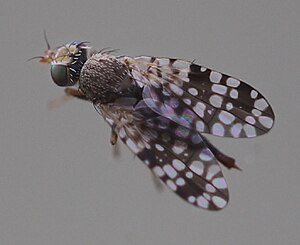Tephritis praecox
| Tephritis praecox | ||||||||||||
|---|---|---|---|---|---|---|---|---|---|---|---|---|

Tephritis praecox |
||||||||||||
| Systematics | ||||||||||||
|
||||||||||||
| Scientific name | ||||||||||||
| Tephritis praecox | ||||||||||||
| ( Loew , 1844) |
Tephritis praecox , also known as the marigold borer fly , is a fly from the family of bored flies (Tephritidae).
features
The drill flies reach a body length of about 3.2 millimeters. Your barrel-shaped abdomen is dark brown to black in color. Mesonotum and shield are colored light brown-beige. The frons are light brown-orange in color. The compound eyes shimmer green. The legs are orange with dark spots on the femora . The wings show a species-specific pattern of black and white spots.
distribution
Tephritis praecox has its main distribution center in the Mediterranean area. The occurrence of the species extends in the south to North Africa and the Canary Islands , in the north via France and the Benelux to southern England. In Switzerland and Austria, the species has established itself in the recent past. There are individual finds in the Upper Rhine Graben. In the east the distribution area extends over the Middle East to Central Asia ( Afghanistan ).
Way of life
The drill fly species mainly uses the field marigold ( Calendula arvensis ), the subshrubric marigold ( Calendula suffruticosa ) and the French feltwort ( Filago gallica ) as host plants . The larvae develop in the flower heads of their host plants. Drill flies can be observed from the beginning of June.
Individual evidence
- ↑ a b Tephritis praecox in Fauna Europaea. Retrieved May 4, 2019
- ↑ a b Tephritis precox . bladmineerders.nl. Retrieved June 9, 2020.
Web links
- Tephritis praecox at www.naturespot.org.uk
- Tephritis praecox at aramel.free.fr
